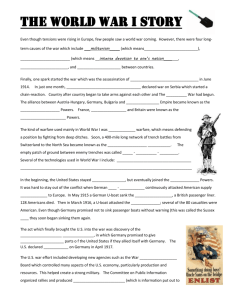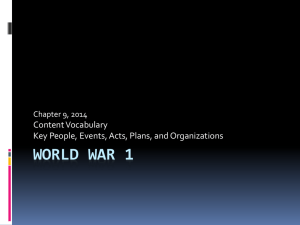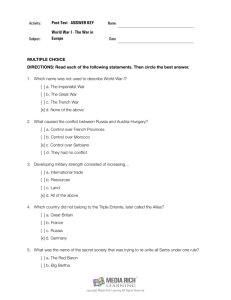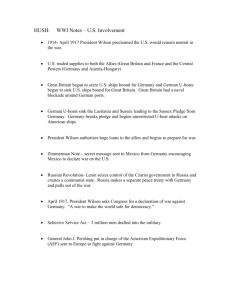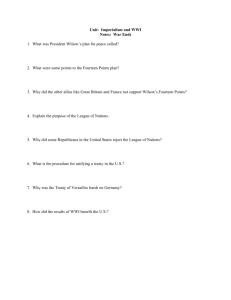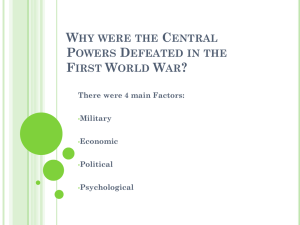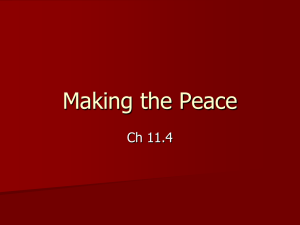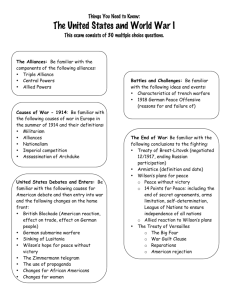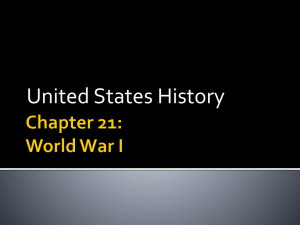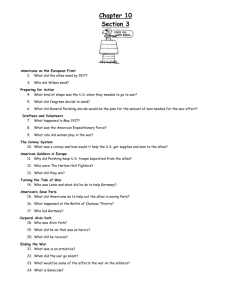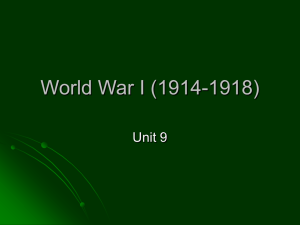World War I
advertisement
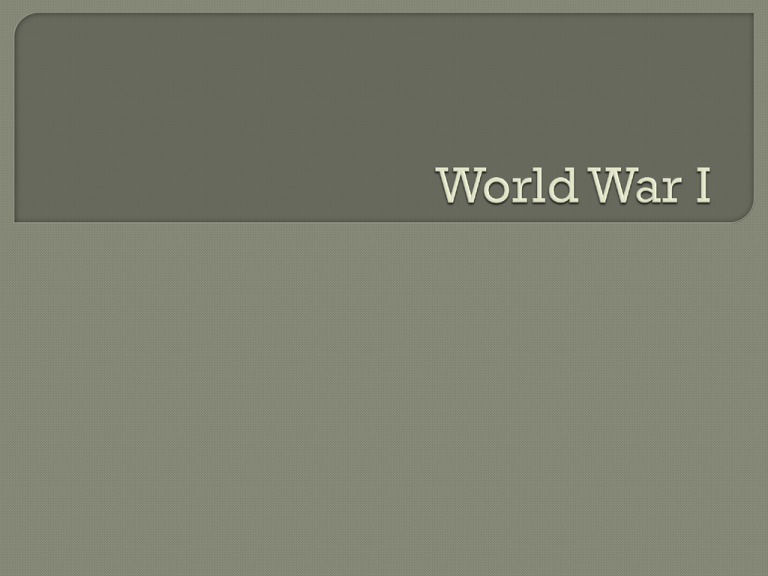
ENTRY # 29 While Watching the Film, answer the Page of questions provided Europe, Before WWI Europe, After WWI Was it worth10 million dead and 20 million more casualties? Militarism: Glorification of military and warfare Naval arms race between the Total Defense Spending of Germany, AustriaGermans and the Hungary, Italy, Britain, France & Russia (in million £) British. 1870 1880 1890 1900 1910 1914 94 130 154 268 289 398 Imperial competition created tension Elaborate and farreaching system of alliances, including imperial holdings The Triple Entente (“The Allies”): France, Russia, Great Britain (on the side of Serbia) VS The Triple Alliance (“Central Powers”/“The Axis”): Germany, Italy, Austria-Hungary (plus Ottoman Empire) Green: Allied Powers Yellow: Central/Axis Powers The beginning of the conflict was the assassination of Archduke Francis Ferdinand of AustriaHungary by a Serbian nationalist, Gavrilo Princip. (6/28/1914) Austria declared war on Serbia, invoking a series of alliances to jump into the war…a domino effect. 1. 2. 3. 4. 5. 6. 7. Austria-Hungary attacked Serbia (7/27/1914) Russia ordered mobilization of troops in defense of ally, Serbia (7/29/1914) Germany, ally of Austria, declared war on Russia, (8/1/1914) Germany then attacked France, ally of Russia, through Belgium (Schlieflen Plan) (8/3/1914) Britain then declared war on Germany over attack on ally, France/Belgium (8/4/1914) Note: Italy did not jump in on “their side” This all took about 2 weeks…”The Guns of August” The fighting on the Western Front primarily occurred in France and Belgium…a near stalemate Most of it “fought” in Trenches…about 12,000 zigzagging, barb-wire-lined trenches on each side facing each other Machine Guns & Massive Artillery Tanks to cross trenches Total war is a war in which a “belligerent” engages in the complete mobilization of every available resource and member of the population. In the mid-19th century, "total war" was identified by scholars as a separate class of warfare. In a total war, there is less differentiation between combatants and civilians than in other conflicts, and sometimes no such differentiation at all, as nearly every human resource, civilians and soldiers alike, can be considered to be part of the belligerent effort “Impartial in thought as well as action” –Woodrow Wilson At the Beginning of the War, the United States considered the war Europe’s problem and did not want to deal with it (Isolationism) There was private support for both sides in the War (although greater support for the Allies) Wilson took the official stance of Neutrality (“Impartial in thought as well as action”) …He picked no side; Instead, an Internationalist, Wilson tried to use US influence to end the War and bring peace. The British blockaded German ports, seized ships trying to run the blockade, and confiscated any contraband materials that could help the German war effort. Despite the naval arms race before the war, the Germans did not have a large enough surface fleet to break through this blockade. Instead, the Germans created their own blockade around Great Britain, using submarines (U-boats) They (mostly) sank ships that carried Allied supplies, Many such supplies came from the United States…The US traded far more with the Allies than with Axis powers, and provided the Allies with almost $3 billion in loans (so not quite neutral). A passenger ship, which German officials (probably correctly) claimed was also carrying ammunition and other war materials. Sunk by the German U-boat torpedoes on May 7,1915. Killed 1198, including 128 Americans. We warned Germany to stop sinking unarmed passenger ships… Called the Sussex Pledge However, as 1917 rolled around, the Germans changed tactics and began unrestricted submarine warfare again, hoping to cut off Allied supplies and win the war before the US entered… Meanwhile, The German Foreign Minister, Arthur Zimmermann, sent Mexico a telegram stating that if Mexico declared war on the US that Germany would help Mexico take back Texas, New Mexico, and Arizona. German U-boats and telegrams pushed US public opinion against the Germans, as had German brutality in their march through Belgium toward France (Schlieffen Plan) American poster using the "Rape of Belgium" to raise money for War Bonds, 1918 Why did the US enter WWI? Please explain in a full paragraph. There are multiple reasons…what do you believe to be the main cause? Prior to US entry into the War, the US Army and Navy were unprepared for a major War. Recognizing this, the US Government began increasing armed forces expenditures to expand both the Army and Navy The National Defense Act – June, 1916 increased the standing army to 175,000. Congress approved the immediate construction of 50 new warships. But once war was declared in April, 1917, there was much more work to do… 1. Create a War Economy (we need weapons) 2. Recruit an Army (we need men to shoot the weapons) 3. Mobilize Public Opinion for the War. (convince the public that our men should go shoot weapons in other countries) (And we needed to this quickly – 1917 was a race against time and the Germans, who were preparing to deliver a knock-out blow!) Wilson created The War Industries Board, which regulated all industries involved in the War effort. The Food Administration Americans asked to conserve food as a patriotic gesture and so that food could be shipped to the Allies, and to our own troops, once they arrived. The Fuel Administration directed efforts to save coal and other fuels. The National War Labor Board worked to settle disputes between labor and employers to keep manufacturing going. War is expensive - The war government raised $33 billion for the war effort through a combination of (a)increased taxes (income, corporate and excise/luxury) and (b) the sale of Liberty and Victory Bonds While the US raised and trained the Army, we shipped munitions, food, and other supplies to the Allies. June, 1917- Congress passed the Selective Service Act. All men ages 18-45 were supposed to register for the Draft. 2.8 Million were actually drafted into the Army during the war. 2 million soldiers would be shipped overseas to fight alongside the British and French in the Trenches. Some men registered as conscientious objectors. (were not morally allowed to fight) Many men never responded to the draft. John T. Neufeld was a Mennonite World War I conscientious objector sentenced to 15 years hard labor in the military prison at Leavenworth. He was paroled to do dairy work and released after serving five months of his sentence. His diary of army and prison life is published in a collection with three other WWI Mennonite conscientious objectors. The Committee on Public Information (CPI), headed by George Creel, printed lots of Propaganda, which “educated” Americans about why they should fight, “educated” Americans about the nature of the enemy (Germans especially were labeled as monsters) and dramatized the needs of America and her allies. “Propaganda is a form of communication aimed at influencing the attitude of a community toward some cause or position“ A) B) C) D) E) F) War enthusiasm and propaganda created serious anti-German prejudice in the US, which resulted in violence against German Americans and rejection of German culture in the US. During WWI the government did not allow for dissenting opinions. Obstructing army recruiters, or “inciting rebellion” could get you a heavy fine and/or up to 20 years in jail. Over 2000 People were convicted of “disloyal” and “abusive” behavior under various laws during the War. The Sedition Act (1918), made it unlawful to use “disloyal, profane, scurrilous, or abusive language” about America, the Constitution, or US military forces. Schenk v. The United States (1919) upheld the Espionage Act (1917), which gave postal authorities the job to ban treasonous newspapers, magazines, or printed materials of any kind. “Sometimes the need for order is so pressing that the First Amendment Protections of Speech do not apply.” – S v.US decisions Under the Sedition Act, Eugene Debs went to prison for 10 years because of an anti-war Speech. The Great Migration of African Americans from the Jim Crow South to the northern cities, which had started before the war, increased with job opportunities/openings during the war. Many other African Americans enlisted as soldiers. Likewise, Mexicans immigrated to the US with increased demand for farmworkers, then often moved west to California, or to the North to fill those vacancies created by the war. Women moved into the workforce, as men joined the military and left job vacancies; many others joined the Army Corps of Nurses. Women’s roles on the home front and as nurses earned President Wilson’s support for suffrage… and helped win passage of the 19th Amendment in 1919/1920. While the US raised and trained its military (and built new ships), we shipped munitions, food, and other supplies to the Allies. Getting these supplies to the Allies required the use of BritishAmerican convoys, groups of merchant ships protected by warships. General John J. Pershing led the AEF (American Expeditionary Force) to France in June, 1917. His one specific order from Wilson was to “maintain a separate American Army” In November, 1917 a communist revolution occurred in Russia. The new Russian Government signed a peace treaty with Germany (Treaty of Brest – Litovsk March, 1918), and Russia pulled out of the war, allowing a great German offensive on the Western Front…uh-oh…good thing the US was sending troops there in large numbers by this time! Vladimir Len, leader of the Russian Revolution In battles such as the 2nd Battle of the Marne, and the Battle of Cantigny, the Allies, supported by large American forces, defended against the German offensive, then counter-attacked at Belleau Wood, and finally went on the offensive along the Meuse River and through the Argonne Forest. The Fighting ended on November 11, 1918, When Germany signed an armistice (on a railway car in France) Wilson, desiring a “peace without victory” had Fourteen Points for his peace treaty, including: 1.Open Diplomacy: No Secret Treaties 2.Freedom of the Seas and Trade 3.Self Determination: countries/nationalities to form their own destinies, especially within the former A-H Empire, and including decolonization 4.Reduction of armaments 5.League of Nations: a general association of nations to settle disputes, and protect the independence and territorial integrity of nations,*** (Still trying to “Make the World safe for Democracy”) Instead, the Allies wanted revenge (A peace with lots of victory) and The Big Four created the Treaty of Versailles, which included: 1.War Guilt Clause: Maintained that it was Germany’s fault that the war had happened 2.Reparations: Germany had to pay the GB and France (lots) of money for “starting” the war and for war damages 3.Germany was stripped of its colonies and militarily occupied for 15 years 4.The Axis powers (plus Russia) lost European territories to self determination 5.The only good news for Wilson: League of Nations Many in US thought it was too harsh on Germany Some nationalities (like Irish-Americans) disappointed by “random” and incomplete selfdetermination Isolationists opposed the League of Nations, especially article 10, calling for mutual defense of the signers Wilson tried, but failed to get the votes to ratify the Treaty of Versailles or the League of Nations, thus weakening the League of Nations. Europe, Before WWI Europe, After WWI Was it worth10 million dead and 20 million more casualties?
